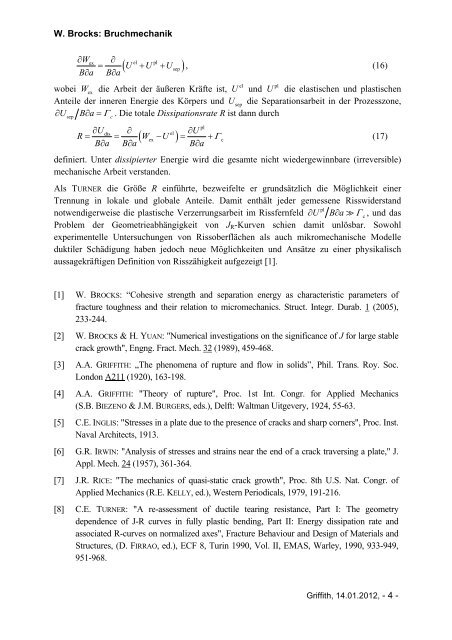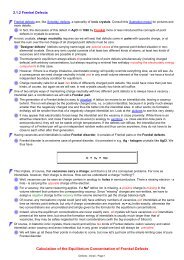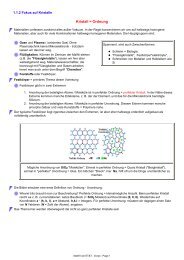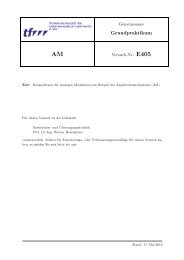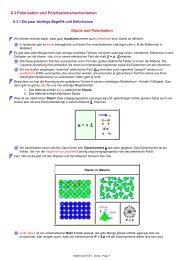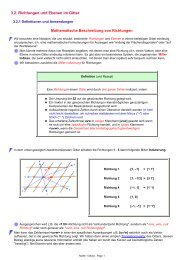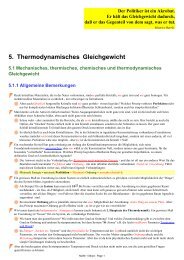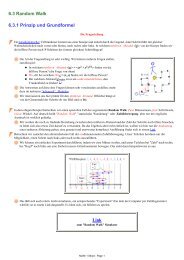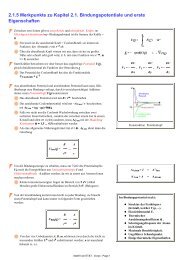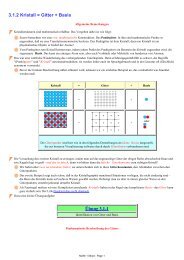Plastizität und Bruchmechanik - Technische Fakultät
Plastizität und Bruchmechanik - Technische Fakultät
Plastizität und Bruchmechanik - Technische Fakultät
Erfolgreiche ePaper selbst erstellen
Machen Sie aus Ihren PDF Publikationen ein blätterbares Flipbook mit unserer einzigartigen Google optimierten e-Paper Software.
W. Brocks: <strong>Bruchmechanik</strong><br />
∂Wex<br />
∂ el pl<br />
= ( U + U + Usep<br />
), (16)<br />
Ba ∂ Ba ∂<br />
el<br />
pl<br />
wobei W<br />
ex<br />
die Arbeit der äußeren Kräfte ist, U <strong>und</strong> U die elastischen <strong>und</strong> plastischen<br />
Anteile der inneren Energie des Körpers <strong>und</strong> U<br />
sep<br />
die Separationsarbeit in der Prozesszone,<br />
∂U B∂ a= Γ . Die totale Dissipationsrate R ist dann durch<br />
sep<br />
c<br />
pl<br />
∂U<br />
∂ el ∂U<br />
= = ( ex<br />
− ) = + Γ<br />
c<br />
Ba ∂ Ba ∂ Ba ∂<br />
dis<br />
R W U<br />
definiert. Unter dissipierter Energie wird die gesamte nicht wiedergewinnbare (irreversible)<br />
mechanische Arbeit verstanden.<br />
Als TURNER die Größe R einführte, bezweifelte er gr<strong>und</strong>sätzlich die Möglichkeit einer<br />
Trennung in lokale <strong>und</strong> globale Anteile. Damit enthält jeder gemessene Risswiderstand<br />
pl<br />
notwendigerweise die plastische Verzerrungsarbeit im Rissfernfeld ∂U B∂a Γ c<br />
, <strong>und</strong> das<br />
Problem der Geometrieabhängigkeit von J R -Kurven schien damit unlösbar. Sowohl<br />
experimentelle Untersuchungen von Rissoberflächen als auch mikromechanische Modelle<br />
duktiler Schädigung haben jedoch neue Möglichkeiten <strong>und</strong> Ansätze zu einer physikalisch<br />
aussagekräftigen Definition von Risszähigkeit aufgezeigt [1].<br />
(17)<br />
[1] W. BROCKS: “Cohesive strength and separation energy as characteristic parameters of<br />
fracture toughness and their relation to micromechanics. Struct. Integr. Durab. 1 (2005),<br />
233-244.<br />
[2] W. BROCKS & H. YUAN: "Numerical investigations on the significance of J for large stable<br />
crack growth", Engng. Fract. Mech. 32 (1989), 459-468.<br />
[3] A.A. GRIFFITH: „The phenomena of rupture and flow in solids”, Phil. Trans. Roy. Soc.<br />
London A211 (1920), 163-198.<br />
[4] A.A. GRIFFITH: "Theory of rupture", Proc. 1st Int. Congr. for Applied Mechanics<br />
(S.B. BIEZENO & J.M. BURGERS, eds.), Delft: Waltman Uitgevery, 1924, 55-63.<br />
[5] C.E. INGLIS: "Stresses in a plate due to the presence of cracks and sharp corners", Proc. Inst.<br />
Naval Architects, 1913.<br />
[6] G.R. IRWIN: "Analysis of stresses and strains near the end of a crack traversing a plate," J.<br />
Appl. Mech. 24 (1957), 361-364.<br />
[7] J.R. RICE: "The mechanics of quasi-static crack growth", Proc. 8th U.S. Nat. Congr. of<br />
Applied Mechanics (R.E. KELLY, ed.), Western Periodicals, 1979, 191-216.<br />
[8] C.E. TURNER: "A re-assessment of ductile tearing resistance, Part I: The geometry<br />
dependence of J-R curves in fully plastic bending, Part II: Energy dissipation rate and<br />
associated R-curves on normalized axes", Fracture Behaviour and Design of Materials and<br />
Structures, (D. FIRRAO, ed.), ECF 8, Turin 1990, Vol. II, EMAS, Warley, 1990, 933-949,<br />
951-968.<br />
Griffith, 14.01.2012, - 4 -


